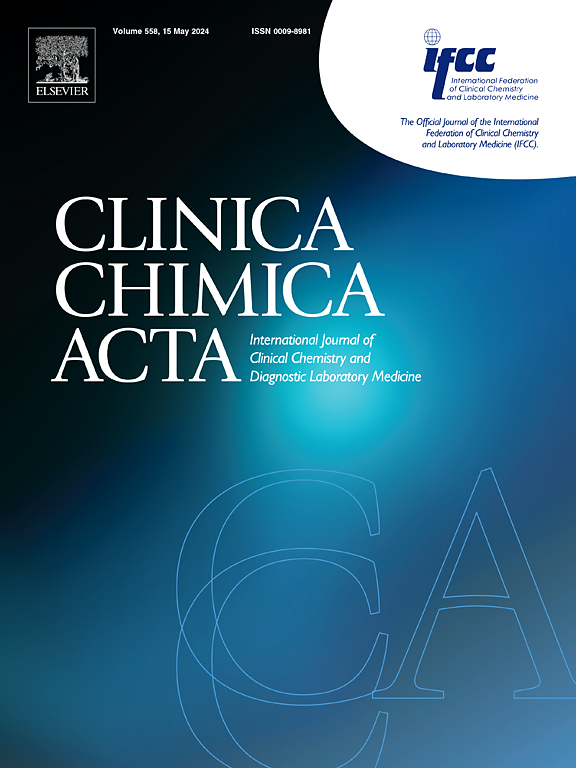S100B in postoperative cognitive impairment: systematic review and meta-analysis
IF 2.9
3区 医学
Q2 MEDICAL LABORATORY TECHNOLOGY
引用次数: 0
Abstract
Background
Postoperative cognitive dysfunction (POCD) is prevalent after cardiac and non-cardiac surgeries. It has been generally accepted that POCD is caused by an inflammatory response. This study aimed to determine whether mini-mental state examination (MMSE) scores and the serum levels of two prominent inflammatory factors, S-100B protein (S-100B) and neuron-specific enolase (NSE), can predict POCD among patients undergoing non-cardiac surgeries.
Method
A comprehensive literature search was conducted using electronic databases such as PubMed, Web of Science, Scopus, Google Scholar, and Embase up to 14, January 2025 to identify eligible observational studies evaluating the relationship between the incidence of POCD and the serum levels of S100B, NSE, and MMSE score before surgery and 24 h and 7 days after surgery among patients undergoing non-cardiac surgeries.
Results
Our findings demonstrated that patients who developed POCD had higher S100B levels 24 h after surgery compared to before surgery. Compared to pre-operative levels, there were no significant differences in S100B levels at 7 days, NSE levels at 24 h or 7 days, and MMSE scores at 24 h or 7 days after surgery. Age-based analysis revealed that patients with POCD aged ≥60 had higher S100B levels at 24 h post-operative. Among different surgery types, S100B and NSE levels increased significantly 24 h after spinal surgery, while MMSE scores significantly decreased after spinal surgery.
Conclusion
S100B may help the early detection of POCD, and the prognostic value of S100B can be evaluated in future studies. Unlike S100B, NSE and MMSE did not show significant differences between POCD and non-POCD groups.
S100B在术后认知功能障碍中的作用:系统回顾和荟萃分析
背景术后认知功能障碍(POCD)在心脏和非心脏手术后普遍存在。人们普遍认为POCD是由炎症反应引起的。本研究旨在确定迷你精神状态检查(MMSE)评分和两种主要炎症因子S-100B蛋白(S-100B)和神经元特异性烯醇化酶(NSE)的血清水平是否可以预测非心脏手术患者的POCD。方法使用PubMed、Web of Science、Scopus、谷歌Scholar、Embase等电子数据库进行综合文献检索,检索截至2025年1月14日的符合条件的观察性研究,评估非心脏手术患者术前、术后24小时和7天血清S100B、NSE和MMSE评分与POCD发生率之间的关系。结果我们的研究表明,发生POCD的患者术后24小时的S100B水平高于术前。与术前相比,术后7天的S100B水平、24 h和7天的NSE水平以及24 h和7天的MMSE评分均无显著差异。基于年龄的分析显示,年龄≥60岁的POCD患者术后24小时的S100B水平较高。在不同手术类型中,脊柱术后24 h S100B和NSE水平显著升高,而MMSE评分显著降低。结论S100B有助于POCD的早期发现,可在今后的研究中评价S100B的预后价值。与S100B不同,NSE和MMSE在POCD组和非POCD组之间没有显著差异。
本文章由计算机程序翻译,如有差异,请以英文原文为准。
求助全文
约1分钟内获得全文
求助全文
来源期刊

Clinica Chimica Acta
医学-医学实验技术
CiteScore
10.10
自引率
2.00%
发文量
1268
审稿时长
23 days
期刊介绍:
The Official Journal of the International Federation of Clinical Chemistry and Laboratory Medicine (IFCC)
Clinica Chimica Acta is a high-quality journal which publishes original Research Communications in the field of clinical chemistry and laboratory medicine, defined as the diagnostic application of chemistry, biochemistry, immunochemistry, biochemical aspects of hematology, toxicology, and molecular biology to the study of human disease in body fluids and cells.
The objective of the journal is to publish novel information leading to a better understanding of biological mechanisms of human diseases, their prevention, diagnosis, and patient management. Reports of an applied clinical character are also welcome. Papers concerned with normal metabolic processes or with constituents of normal cells or body fluids, such as reports of experimental or clinical studies in animals, are only considered when they are clearly and directly relevant to human disease. Evaluation of commercial products have a low priority for publication, unless they are novel or represent a technological breakthrough. Studies dealing with effects of drugs and natural products and studies dealing with the redox status in various diseases are not within the journal''s scope. Development and evaluation of novel analytical methodologies where applicable to diagnostic clinical chemistry and laboratory medicine, including point-of-care testing, and topics on laboratory management and informatics will also be considered. Studies focused on emerging diagnostic technologies and (big) data analysis procedures including digitalization, mobile Health, and artificial Intelligence applied to Laboratory Medicine are also of interest.
 求助内容:
求助内容: 应助结果提醒方式:
应助结果提醒方式:


